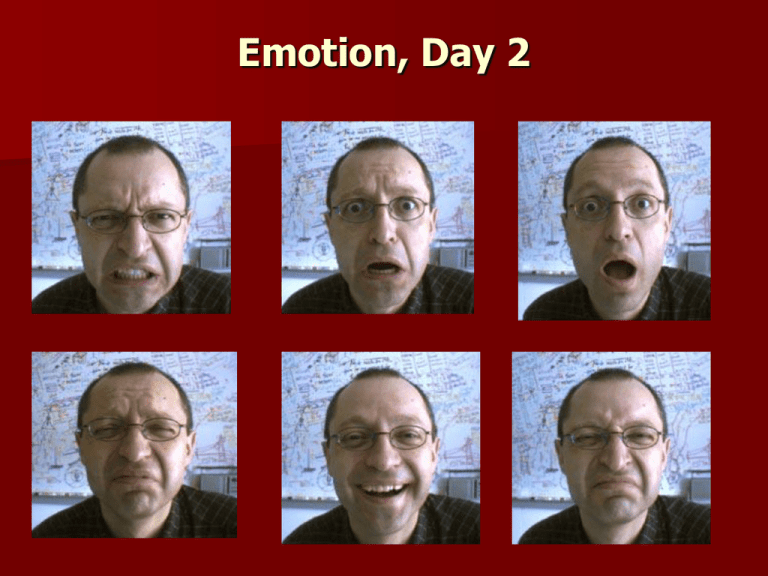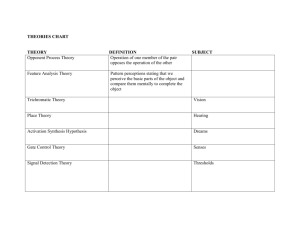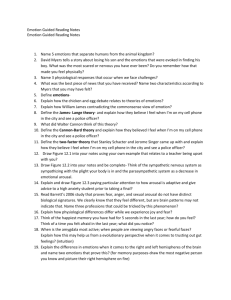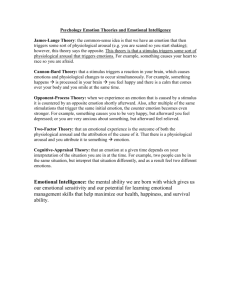Facial Expressions and Theories of Emotions
advertisement

Emotion, Day 2 Emotion is Multifaceted Emotion refers to the mix of: 1. Physiological Arousal 2. Expressive Behaviors (how you react to the physiological arousal) 3. Conscious Experience (how you cognitively interpret environment) Facial Expressions Are Universal No matter what part of the world you are from, facial expressions indicating 6 basic emotions tend to be universal. Facial Expressions Are Universal The six universal emotions are: 1. Happiness Anger Interest (not an emotion) Disgust Surprise Sadness Fear 2. 3. 4. 5. 6. Why the Universality? Evolutionary argue? Perspective would Context Affects Interpretation of Facial Expressions Because of the context, many interpret the bottom monster as fearful while seeing the top monster as angry even though they have the same facial expression. Cultural Differences In Emotion Expression (Different Display Rules) Although the facial language is universal worldwide, cultures differ in how much emotion they express. Western cultures like North America often have intense, prolonged emotional displays while some Eastern cultures like Japan often hide their emotions, especially when the emotion is negative. Effects of Facial Expressions Do we smile because we are happy, or are we happy because we smile? There is an interplay between the emotion and our expression of it. The muscle contractions associated with emotions tend to amplify that emotion. Biology of Fear The body’s control center for learning/enacting fear is the amygdala. Loss or damage to one’s amygdala has lead to fearlessness in some patients. Must Cognition Precede all Emotions? Some pathways, especially ones involving amygdala (fear), bypass cortical areas involved in thinking. Certain likes, dislikes, and fears do ignore conscious thinking. Two Routes to Emotion Physiological activation Appraisal Emotional response Event Expressive behavior Subjective experience Final Emotion Application 5 Points Christine is holding her 8 month-old baby when a fierce dog appears out of nowhere and, with teeth bared, leaps for the baby’s face. Christine immediately ducks for cover to protect the baby, screams at the dog, and notices that her heart is banging and that she’s broken out in a cold sweat. How would the James-Lange, CannonBard, and Two-Factor Theories explain Christine’s reaction? The Physical Arousal of Emotion is Controlled by The Autonomic Nervous System It is very difficult to differentiate the physical arousal associated with many emotions (criticism of James-Lange Theory) even though they definitely feel different. The arousal associated with emotions are controlled by the autonomic nervous system’s divisions the sympathetic and parasympathetic nervous systems. Autonomic Nervous System’s Division Autonomic nervous system controls physiological arousal Parasympathetic Sympathetic division (calming) division (arousing) Pupils dilate EYES Pupils contract Decreases SALIVATION Increases Perspires SKIN Dries Increases RESPIRATION Decreases Accelerates HEART Slows Inhibits DIGESTION Activates Secrete stress hormones ADRENAL GLANDS Decreases secretion of stress hormones Can Measuring Arousal Detect Lies? Polygraph: machine commonly used to in attempts to detect lies. Measures Physiological Responses to Emotion Including: perspiration heart rate blood pressure breathing changes Questioning Process With The “Lie Detector” 1. Subject is asked a Control Question: a type of question where you will give a truthful response (Is your birthday in May?) 2. Ask Relevant Question that you are interested in. Were you at the scene of the crime the day of the murder? If there is a bigger physiological reaction to the relevant question than the control question you are lying. What Arguments Do Critics Make Against the “Lie Detector?” Accuracy of the Polygraph Is Between 70 & 95% Is this a good level of accuracy? With 70% Accuracy: – Assume 5% of 1000 employees actually guilty test all employees 285 will be wrongly accused With 95% Accuracy: – Assume 1 in 1000 employees actually guilty test all employees (including 999 innocents) 50 wrongly declared guilty Polygraph Accuracy Study Percentage 80 70 60 50 40 30 20 10 0 Innocent people Judged innocent by polygraph Judged guilty by polygraph Guilty people Detecting Emotion/Lies With Facial Expressions Paul Ekman developed a system for classifying deception within emotional expression. With experience and training it is possible to detect microexpressions which indicate guilt, despair, and fear. Must play close attention to facial muscles which are nearly impossible to control. expressing emotion The Emotion of Anger: Is the Catharsis Theory True? Catharsis: refers to an emotional release. The hypothesis argues that releasing aggressive energy can relieve our aggressive urges.








